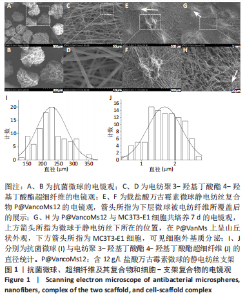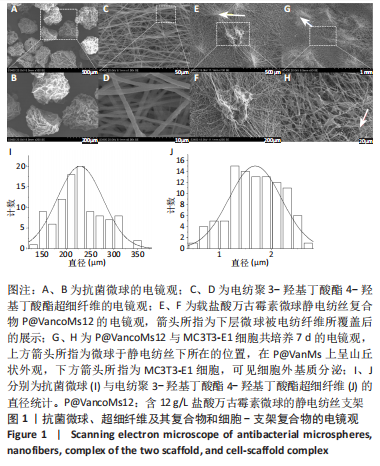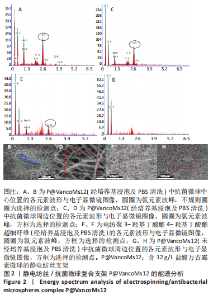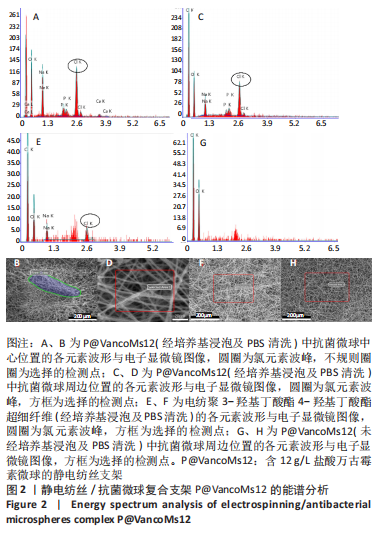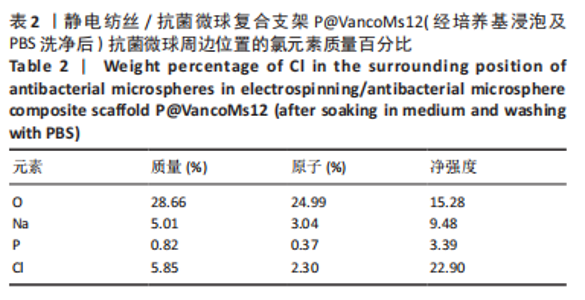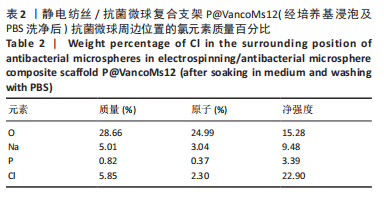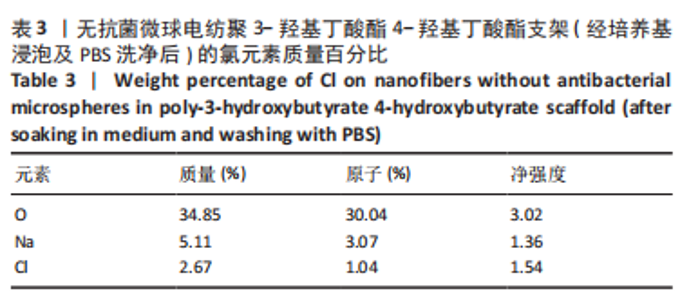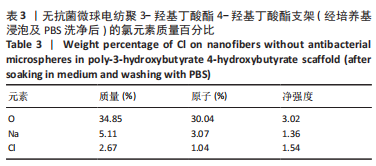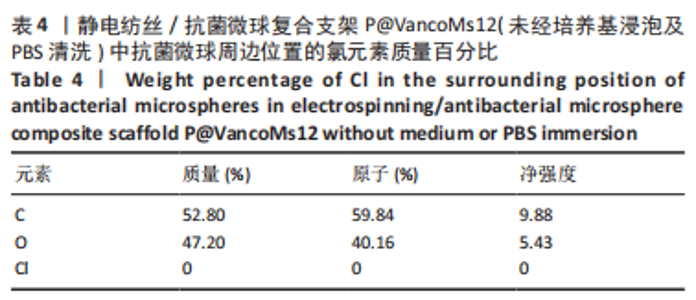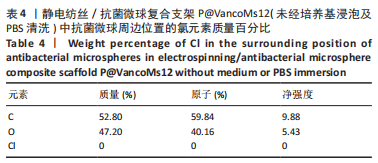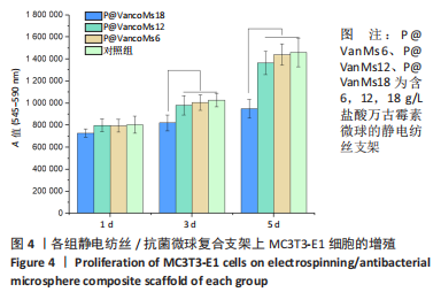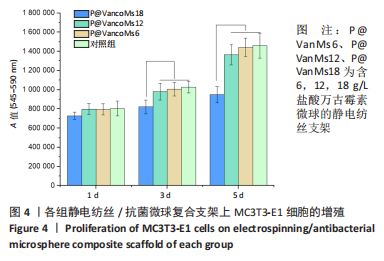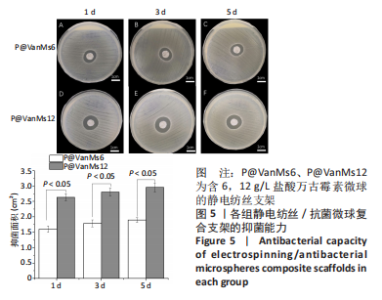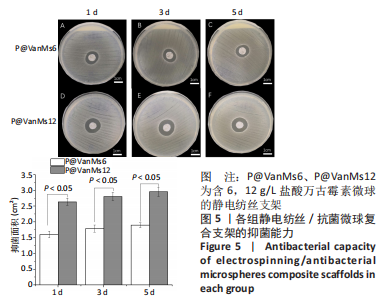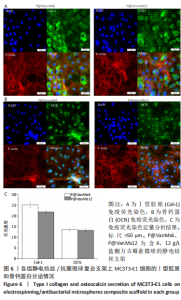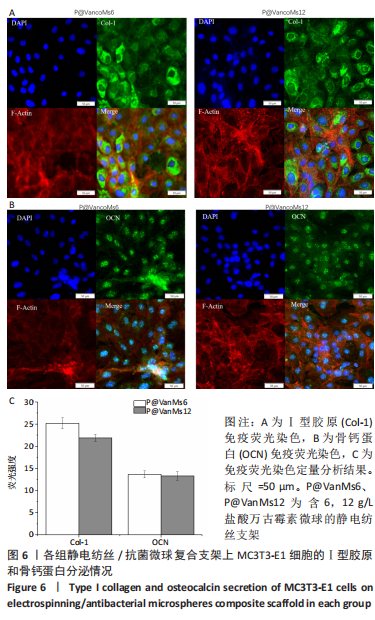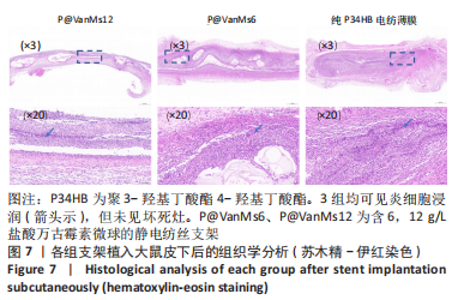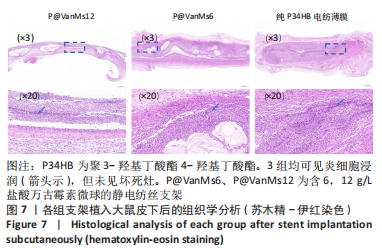Chinese Journal of Tissue Engineering Research ›› 2023, Vol. 27 ›› Issue (16): 2534-2541.doi: 10.12307/2023.462
Previous Articles Next Articles
Preparation and property analysis of electrospinning composite sustained-release antibacterial microspheres
Yang Yong1, Xu Shunen2, Gu Xianyang1, Hua Dawei1, Teng Jianxiang1, Wang Zhen1, Ye Chuan1, 2, 3
- 1Guizhou Medical University, Guiyang 550004, Guizhou Province, China; 2Department of Orthopedics, Affiliated Hospital of Guizhou Medical University, Guiyang 550004, Guizhou Province, China; 3Department of Orthopedics, Affiliated Hospital of Guiyang Medical College, Guiyang 550004, Guizhou Province, China
-
Received:2022-04-11Accepted:2022-06-02Online:2023-06-08Published:2022-11-10 -
Contact:Ye Chuan, Chief physician, Guizhou Medical University, Guiyang 550004, Guizhou Province, China; Department of Orthopedics, Affiliated Hospital of Guizhou Medical University, Guiyang 550004, Guizhou Province, China; Department of Orthopedics, Affiliated Hospital of Guiyang Medical College, Guiyang 550004, Guizhou Province, China -
About author:Yang Yong, Master candidate, Physician, Guizhou Medical University, Guiyang 550004, Guizhou Province, China
CLC Number:
Cite this article
Yang Yong, Xu Shunen, Gu Xianyang, Hua Dawei, Teng Jianxiang, Wang Zhen, Ye Chuan. Preparation and property analysis of electrospinning composite sustained-release antibacterial microspheres[J]. Chinese Journal of Tissue Engineering Research, 2023, 27(16): 2534-2541.
share this article
Add to citation manager EndNote|Reference Manager|ProCite|BibTeX|RefWorks
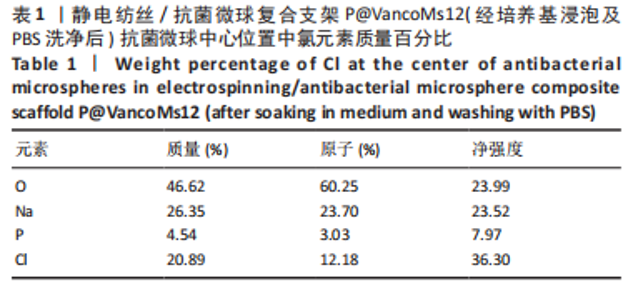
结果显示,氯元素为盐酸万古霉素的特征性元素,complex1可见其波峰较高(圆圈处);complex2仍有氯元素的特征性波峰(圆圈处),但较complex1低。complex3同样含有氯元素的特征性波峰(圆圈处),但含量较complex2低,考虑其氯元素来源为培养基及PBS中的氯化钠;complex4不含氯元素的特征性波峰,这是由于P34HB及海藻酸钠中不含氯元素,证明了未经液体浸泡的复合支架其中的盐酸万古霉素不会释放出来。对complex1、complex2、complex3、complex4中各种元素量化后结果,见表1-4,各组中氯元素含量百分比大小排列为:complex1 > complex2 > complex3 > complex4,各组间比较差异有显著性意义(P < 0.01)。P@VancoMs12中抗菌微球周边位置的氯元素含量仍大于经培养基浸泡及PBS洗净后的不含盐酸万古霉素微球的P34HB电纺丝中的氯元素含量,则表明微球仍在持续释放盐酸万古霉素。"
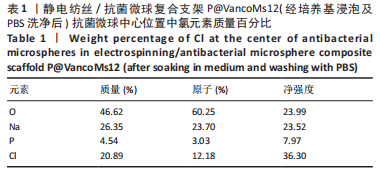
| [1] HAMM CA, HAMPE O, SCHWARZ D, et al. A comprehensive diagnostic approach combining phylogenetic disease bracketing and CT imaging reveals osteomyelitis in a Tyrannosaurus rex. Sci Rep. 2020;10(1):18897. [2] WOODS CR, BRADLEY JS, CHATTERJEE A, et al. Clinical Practice Guideline by the Pediatric Infectious Diseases Society and the Infectious Diseases Society of America: 2021 Guideline on Diagnosis and Management of Acute Hematogenous Osteomyelitis in Pediatrics. J Pediatric Infect Dis Soc. 2021;10(8):801-844. [3] PREMKUMAR A, KOLIN DA, FARLEY KX, et al. Projected Economic Burden of Periprosthetic Joint Infection of the Hip and Knee in the United States. J Arthroplasty. 2021;36(5):1484-1489.e3. [4] ARCIOLA CR, AN YH, CAMPOCCIA D, et al. Etiology of implant orthopedic infections: a survey on 1027 clinical isolates. Int J Artif Organs. 2005;28(11):1091-1100 [5] WALTER G, KEMMERER M, KAPPLER C, et al. Treatment algorithms for chronic osteomyelitis. Dtsch Arzteblatt Int. 2012;109(14):257-264. [6] 苏珊,何娜,翟所迪.儿童患者万古霉素初始给药方案的分析[J].中国临床药理学杂志,2021,37(5):576-579+595. [7] HUMPHREY C, VEVE MP, WALKER B, et al. Long-term vancomycin use had low risk of ototoxicity. PLoS One. 2019;14(11):e0224561. [8] 吴婧,刘小兰,郭德群,等.替考拉宁和万古霉素治疗脊柱后路术后手术深部耐甲氧西林革兰阳性菌感染的临床疗效[J].中华医院感染学杂志,2020,30(18):2790-2793. [9] GUO Y, SONG G, SUN M, et al. Prevalence and Therapies of Antibiotic-Resistance in Staphylococcus aureus. Front Cell Infect Microbiol. 2020; 10:107. [10] 化昊天,王新卫,张磊,等.慢性骨髓炎的诊疗研究进展[J].中国骨与关节杂志,2022,11(2):132-136. [11] CYPHERT EL, LU CY, MARQUES DW, et al. Combination antibiotic delivery in pmma provides sustained broad-spectrum antimicrobial activity and allows for postimplantation refilling. Biomacromolecules. 2020;21(2):854-866. [12] 尤加省,李宏烨,刘超.载抗生素骨水泥在治疗下肢感染性创面中的疗效分析[J].中国骨伤,2021,34(7):670-673. [13] XUE JJ, WU T, DAI YQ, et al. Electrospinning and Electrospun Nanofibers: Methods, Materials, and Applications. Chem Rev. 2019;119:5298-5415. [14] CHEN ZY, SONG Y, ZHANG J, et al. Laminated electrospun nHA/PHB-composite scaffolds mimicking bone extracellular matrix for bone tissue engineering. Mat Sci Eng C. 2017;72:341-351. [15] BOCK N, DARGAVILLE TR, WOODRUFF MA. Electrospraying of polymers with therapeutic molecules: state of the art. Prog Polym Sci. 2012; 37(11):1510-1551. [16] JAWOREK A, SOBCZYK AT. Electrospraying route to nanotechnology: an overview. J Electrostat. 2008;66(3-4):197-219 [17] 马博,顾勇,陈亮.骨修复缓释微球的应用进展[J].实用骨科杂志, 2022,28(2):142-145+149. [18] YE C, HU P, MA M, et al. PHB/PHBHHx scaffolds and human adipose-derived stem cells for cartilage tissue engineering. Biomaterials. 2009; 30(7):4401-4406. [19] MA MX, LIU Q, YE C, et al. Preparation of P3HB4HB/(gelatin+PV A) composite scaffolds by coaxial electrospinning and its bio-compatibility evaluation. BioMed Res Int. 2017;2017:9251806. [20] 张静,林华庆,马秋燕,等.海藻酸钠及其衍生物在生物医药中的应用进展[J].中国药房,2019,30(23):3307-3312. [21] 毛金超,隋振全,徐桂云,等.天然生物质材料的制备、性质与应用(Ⅱ)——pH敏感型功能海洋多糖:海藻酸钠[J].日用化学工业, 2022,52(2):124-133. [22] JUNTAPRAM K, PRAPHAIRAKSIT N, SIRALEARTMUKUL K, et al. Electrosprayed polyelectrolyte complexes between mucoadhesive N,N,N,-trimethylchitosanhomocysteine thiolactone and alginate/carrageenan for camptothecin delivery. Carbohydr Polym. 2012;90(4): 1469-1479. [23] PARK H, KIM PH, HWANG T, et al. Fabrication of cross-linked alginate beads using electrospraying for adenovirus delivery. Int J Pharm. 2012; 427(2):417-425. [24] COCHRAN AR, ONG KL, LAU E, et al. Risk of reinfection after treatment of infected total knee arthroplasty. J. Arthroplast. 2016;31:156-161. [25] GALLIE WE. First recurrence of osteomyelitis eighty years after infection. J Bone Joint Surg Br. 1951;33-B(1):110-111. [26] LIBRATY DH, PATKAR C, TORRES B. Staphylococcus aureus reactivation osteomyelitis after 75 years. New Engl J Med. 2012;366:481-482. [27] Hogan A, Heppert VG, Suda AJ. Osteomyelitis. Arch Orthop Trauma Surg. 2013;133(9):1183-1196. [28] QIAN G, ZHANG L, LIU X, et al. Silver-doped bioglass modified scaffolds: A sustained antibacterial efficacy. Mater Sci Eng C Mater Biol Appl. 2021; 129:112425. [29] 管捷,程坚,谢幼专,等.含纳米银颗粒的β-磷酸三钙复合支架的抗菌性和促成骨性的研究[J].生物骨科材料与临床研究,2018, 15(2):9-13+82-83. [30] 任亚明,黄晨,刘达,等.一期外固定支架、抗生素骨水泥珠链置入联合负压封闭引流治疗GustiloⅢ型胫腓骨开放性骨折的临床效果[J].中国医刊,2021,56(9):987-989. [31] 周武,夏天,刘梦非,等.Ⅰ期清创联合抗生素骨水泥珠链填塞治疗骨折后慢性感染[J].中华创伤杂志,2018,34(11):1001-1006. [32] 李荣俊,张萌.万古霉素骨水泥填充联合负压封闭引流治疗对慢性骨髓炎患者血清肿瘤坏死因子水平的影响[J].中国现代医生,2021, 59(26):103-106. [33] FATHI M, AKBARI B, TAHERIAZAM A. Antibiotics drug release control-ling and osteoblast adhesion from titania nanotubes arrays using silk fibroin coating. Mat Sci Eng C-Mater. 2019;103:109743. [34] LORA-TAMAYO J, MURILLO O. Shorter treatments for vertebral osteomyelitis. Lancet. 2015;385(9971):836-837. [35] LI H, ROMBACH I, ZAMBELLAS R, et al. Oral versus intravenous antibiotics for bone and joint infection. N Engl J Med. 2019;380(5): 425-436. [36] JELINKOVA P, MAZUMDAR A, SUR VP, et al. Nanoparticle-drug conjugates treating bacterial infections. J Control Release. 2019;307: 166-185. [37] MUNITA JM, ARIAS CA. Mechanisms of antibiotic resistance. Microbiol Spectr. 2016;4(2):10.1128/microbiolspec.VMBF-0016-2015. doi: 10.1128/microbiolspec.VMBF-0016-2015. [38] CHENG CA, DENG T, LIN FC, et al. Supramolecular nanomachines as stimuli-responsive gatekeepers on mesoporous silica nanoparticles for antibiotic and cancer drug delivery. Theranostics. 2019;9(11):3341-3364 [39] DZIEMIDOWICZ K, SANG Q, WU J, et al. Electrospinning for healthcare: recent advancements. J Mater Chem B. 2021;9(4):939-951. [40] DHAMECHA D, MOVSAS R, SANO U, et al. Applications of alginate microspheres in therapeutics delivery and cell culture: Past, present and future. Int J Pharm. 2019;569:118627. [41] WANG W, LIU Y, LIU Z, et al. Evaluation of Interleukin-4-Loaded Sodium Alginate-Chitosan Microspheres for Their Support of Microvascularization in Engineered Tissues. ACS Biomater Sci Eng. 2021;7(10):4946-4958. [42] ANTOCI V JR, ADAMS CS, HICKOK NJ, et al. Antibiotics for local delivery systems cause skeletal cell toxicity in vitro. Clin Orthop Relat Res. 2007; 462:200-206. |
| [1] | Zhong Yizheng, Huang Peizhen, Cai Qunbin, Zheng Liqin, He Xingpeng, Dong Hang. Microstructural indexes that determine the trabecular bone maximum stress of micro-finite element models [J]. Chinese Journal of Tissue Engineering Research, 2023, 27(9): 1313-1318. |
| [2] | Wu Tianliang, Tao Xiuxia, Xu Hongguang. Influence of different bone mineral densities on cage subsidence after stand-alone oblique lateral interbody fusion: three-dimensional finite element analysis [J]. Chinese Journal of Tissue Engineering Research, 2023, 27(9): 1352-1358. |
| [3] | Wen Xinghua, Ding Huanwen, Cheng Kai, Yan Xiaonan, Peng Yuanhao, Wang Yuning, Liu Kang, Zhang Huiwu. Three-dimensional finite element model analysis of intramedullary nailing fixation design for large femoral defects in Beagle dogs [J]. Chinese Journal of Tissue Engineering Research, 2023, 27(9): 1371-1376. |
| [4] | Dang Yi, Du Chengyan, Yao Honglin, Yuan Nenghua, Cao Jin, Xiong Shan, Zhang Dingmei, Wang Xin. Hormonal osteonecrosis and oxidative stress [J]. Chinese Journal of Tissue Engineering Research, 2023, 27(9): 1469-1476. |
| [5] | Sun Jiajia, Zhu Haidi, Lu Yun, Zhang Kai. Comparison of bone metabolism markers between type 2 diabetes mellitus and non-type 2 diabetes mellitus patients with hip fracture [J]. Chinese Journal of Tissue Engineering Research, 2023, 27(8): 1156-1160. |
| [6] | Huang Linke, Wei Linhua, Jiang Jie, Liu Qian, Chen Weiwei. Effects of estrogen combined with treadmill exercise on bone mass and articular cartilage in ovariectomized mice [J]. Chinese Journal of Tissue Engineering Research, 2023, 27(8): 1166-1171. |
| [7] | Yang Zhishan, Tang Zhenglong. YAP/TAZ, a core factor of the Hippo signaling pathway, is involved in bone formation [J]. Chinese Journal of Tissue Engineering Research, 2023, 27(8): 1264-1271. |
| [8] | Bai Yulong, Li Zhonghai, Zhao Yantao, Xia Cencan, Shi Lei. History, current situation and prospect of tissue banks in China [J]. Chinese Journal of Tissue Engineering Research, 2023, 27(8): 1306-1312. |
| [9] | Liu Jiaxin, Jia Peng, Men Yutao, Liu Lu, Wang Yeming, Ye Jinduo. Design and optimization of bone trabecular structure with triply periodic minimal surfaces [J]. Chinese Journal of Tissue Engineering Research, 2023, 27(7): 992-997. |
| [10] | Liu Xiaolin, Mu Xinyue, Ma Ziyu, Liu Shutai, Wang Wenlong, Han Xiaoqian, Dong Zhiheng. Effect of hydrogel-loaded simvastatin microspheres on osteoblast proliferation and differentiation [J]. Chinese Journal of Tissue Engineering Research, 2023, 27(7): 998-1003. |
| [11] | Yuan Hucheng, Ding Yongguo, Ma Xuehua, Ma Wenxin, Sun Jianmin, Wang Zili, Jin Weidong. Sustained releasing of pyrazinamide, capreomycin, moxifloxacin and amikacin loaded bone cement in vitro [J]. Chinese Journal of Tissue Engineering Research, 2023, 27(7): 1017-1022. |
| [12] | Zhao Wei, Feng Wei, Yang Tieyi, Ren Wei, Wang Yuxin, Lyu Huicheng, Chang Zhiqiang, Feng Xiaodong, Wang Ziheng, Guo Shibing. Antibiotic bone cement intramedullary nail prepared using 3D printed mold for the treatment of long bone infection in lower limbs [J]. Chinese Journal of Tissue Engineering Research, 2023, 27(7): 1023-1030. |
| [13] | Sun Jiangwei, Wang Junxiang, Baibujiafu·Yellisi, Dai Huijuan, Nijati·Turson. Three-dimensional finite element analysis of stress distribution in different smooth collar implants [J]. Chinese Journal of Tissue Engineering Research, 2023, 27(7): 1004-1011. |
| [14] | Zhang Tingting, Liu Juan, Zhang Xu. Bioactivity of phase-transition lysozyme for surface modification of zirconia all-ceramic implant material mediating hydroxyapatite coating [J]. Chinese Journal of Tissue Engineering Research, 2023, 27(7): 1043-1049. |
| [15] | Yang Yitian, Wang Lu, Yao Wei, Zhao Bin. Application of the interaction between biological scaffolds and macrophages in bone regeneration [J]. Chinese Journal of Tissue Engineering Research, 2023, 27(7): 1071-1079. |
| Viewed | ||||||
|
Full text |
|
|||||
|
Abstract |
|
|||||
